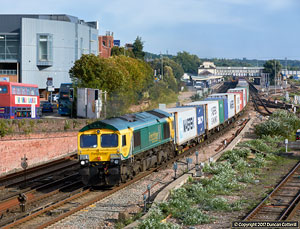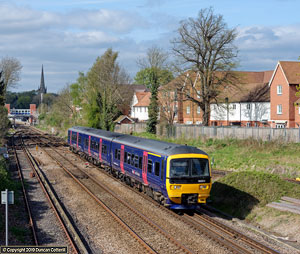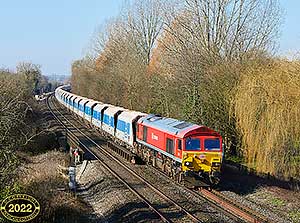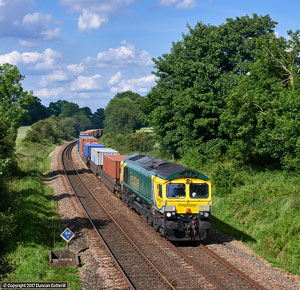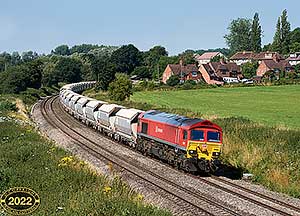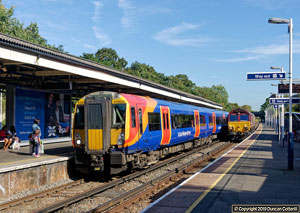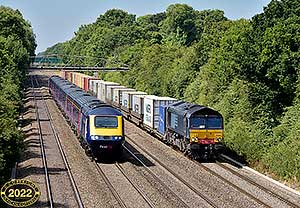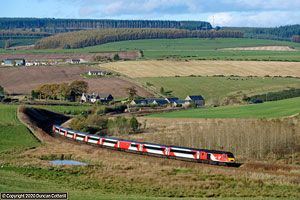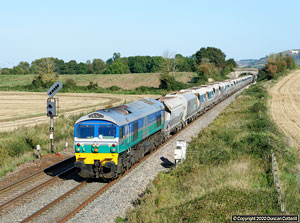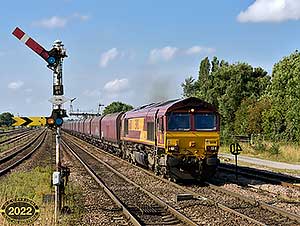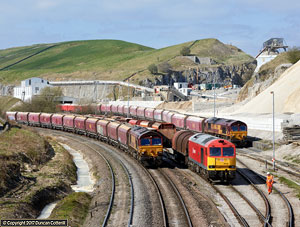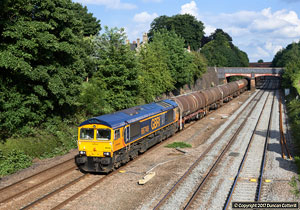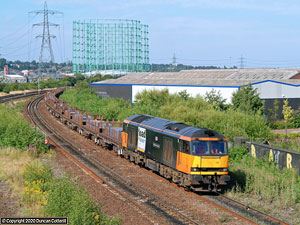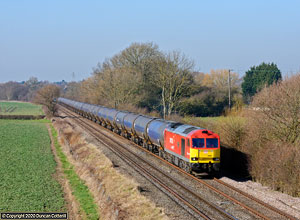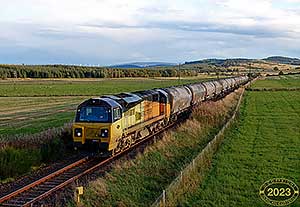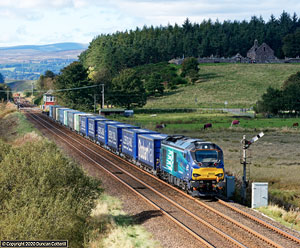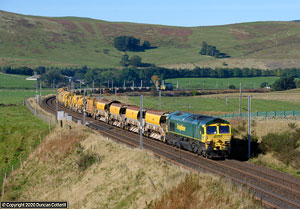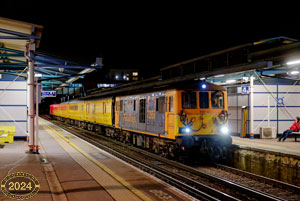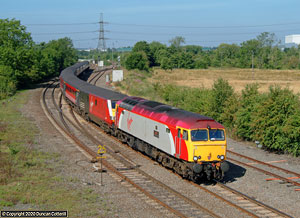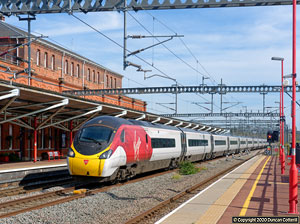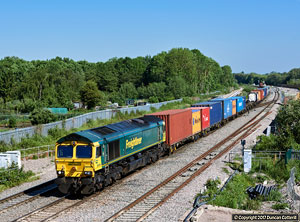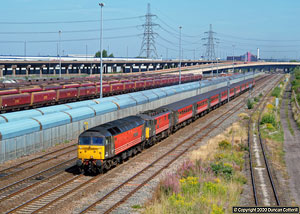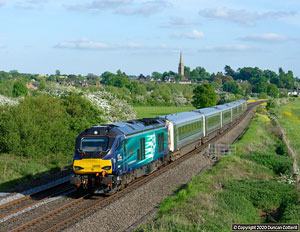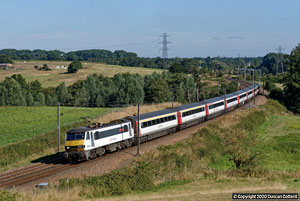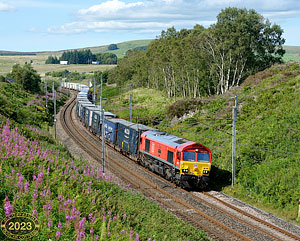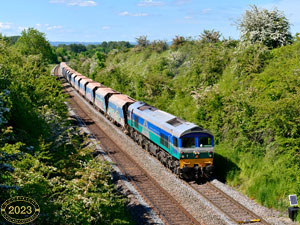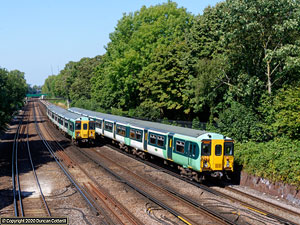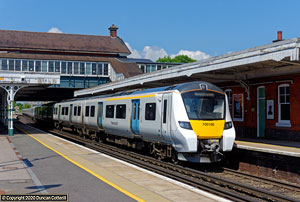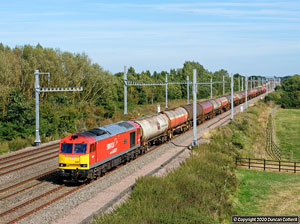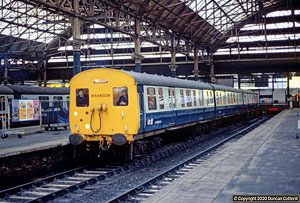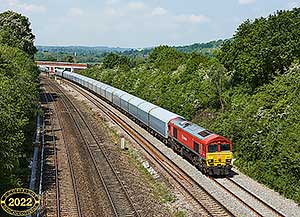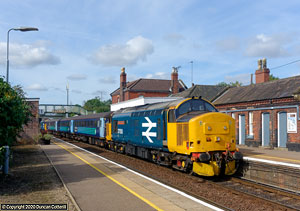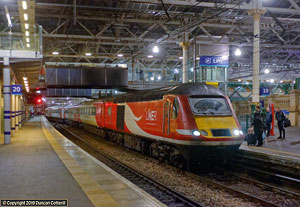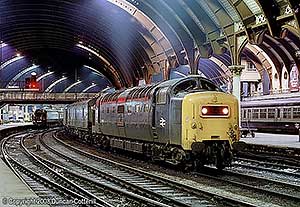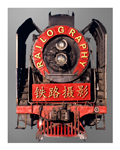158 Waterloo - Weymouth
341 photos
updated : 2024-02-29
This 143 mile line, electrified at 750V DC, provides a vital link from London to Southampton and much of Hampshire and Dorset. West of Basingstoke it also carries traffic from the Midlands and further north to the south coast, including significant volumes of freight to and from Southampton docks.
148 Reading - Redhill
91 photos
updated : 2024-02-29
The 46 mile Reading - Redhill line was completed in 1849 by the South Eastern Railway. Although some of the route is electrified, there are two lengthy gaps and through passenger services are worked by DMUs. There is no regular freight traffic but the line sees test trains and the occasional diverted freight.
Reading Area
136 photos
updated : 2024-02-29
This gallery brings together photos taken within a radius of 3 miles of Reading station on the various lines radiating from this major junction on the Great Western Main Line, 36 miles west of London. Locations include Sonning Cutting and Southcote Junction, both now ruined by electrification.
122 Reading - Basingstoke
16 photos
updated : 2024-02-29
The Reading - Basingstoke line is a busy 14 mile double-track railway that forms part of the principal route from the Midlands to the port of Southampton and the south coast resorts. Freight traffic, mainly containers and automotive, is heavy and there are also frequent local and long distance passenger trains.
135 Reading - Westbury
395 photos
updated : 2024-02-27
The scenic Berks and Hants line is part of the most direct route from London to Taunton and beyond. It handles expresses from London to the West of England and local trains as far as Bedwyn but the main interest is the heavy aggregates traffic from the Mendip quarries to the London area.
149 Waterloo - Reading & branches
102 photos
updated : 2024-02-23
The line from Waterloo to Reading, its branches to Windsor and Weybridge and the Hounslow loop are known as the Windsor Lines. Commuter traffic to and from London worked by South Western Railway EMUs dominates but the line also sees through freight traffic routed to the LSWR main line via Chertsey.
125 Paddington - Reading
146 photos
updated : 2024-02-23
The four track main line from Reading to Paddington was one of Britain’s busiest diesel worked routes, carrying frequent HSTs and DMUs from London to the west. Freight traffic includes container, steel and stone trains. The line is still busy but electrification had ruined all the good photo locations by late 2016.
229 Dundee - Aberdeen
251 photos
updated : 2024-02-21
The line from Dundee north to Aberdeen is quite scenic and follows the coast part of the way. It's fairly busy these days with short HSTs on most Glasgow and Edinburgh trains and DMUs on local services. There are also a few regular freights, the Caledonian Sleeper and semaphore signals to add to the interest.
135 Westbury - Cogload Jn
78 photos
updated : 2024-02-08
This line forms the western part of the GWR's direct route from Reading to Taunton. The Westbury end is busy with local trains on the Bristol - Weymouth route and stone trains from the Mendip quarries but further west there's little traffic apart from the through expresses between London and the west.
029 North Lincolnshire Lines
60 photos
updated : 2024-02-02
Barnetby lies at the junction of 3 former Great Central Railway routes leading to the east coast ports of Immingham and Grimsby. Immingham still generates a high volume of freight traffic for the energy and steel industries with regular coal, biomass, iron ore and oil trains worked by a variety of loco classes.
078 Peak District
87 photos
updated : 2024-01-30
The Hope Valley line from Sheffield to Manchester and the freight lines around Peak Forest and Buxton make attractive subjects for photography. The local quarries generate significant volumes of traffic as does the cement works at Hope. As a bonus, there are still semaphore signals at several locations.
053 Midland Main Line
39 photos
updated : 2024-01-28
The Midland route from St Pancras to Sheffield via Derby, Toton or Nottingham is relatively quiet compared to the East or West Coast routes but carries significant volumes of freight, particularly north of Leicester. Electrification only reaches Kettering at the moment but is currently being extended northwards.
057 Birmingham - Derby
24 photos
updated : 2024-01-28
The former Midland Railway route from Birmingham to Derby is an important part of the North-East to South-West corridor, linking Yorkshire and the East Midlands with the West Midlands, South Wales and the South West. It continues to be busy with passenger traffic and also sees a significant volume of freight.
054 Stenson Jn - Sheet Stores Jn
22 photos
updated : 2024-01-28
This short section of freight line runs for 12 miles from Stenson Junction, south of Derby on the Birmingham line, to Sheet Stores Junction, south-east of Derby on the route to Trent Junction, leading to Toton, Nottingham and Leicester. The line sees no regular passenger trains but is quite busy with freight traffic.
240 Aberdeen - Inverness
11 photos
updated : 2024-01-21
The Aberdeen to Inverness line is all that remains of a once extensive rail network in North East Scotland. The route is a combination of lines operated by the Highland Railway, west of Keith, and the GNoSR, to the east. Today it is mostly operated by DMUs but a few services are worked by Scotrail HSTs.
229 Glasgow - Dundee
8 photos
updated : 2024-01-21
The line from Glasgow to Dundee via Stirling and Perth is the gateway to the Highlands and the North East, carrying long distance and regional passenger trains as well as a few freights. Passenger services are a mixture of DMUs and short HSTs and there are semaphore signals in places.
065 Carlisle - Glasgow
39 photos
updated : 2024-01-20
The former Caledonian Railway route over Beattock Summit, forms the northern section of the electrified West Coast Main Line. It's busier now than it's ever been but most passenger services are worked by EMUs. There is some freight, much of it diesel hauled despite the line being electrified for many years.
156 Woking - Portsmouth
7 photos
updated : 2024-01-20
The Portsmouth Direct line was opened in 1859 and cut around 20 miles off the distance between Portsmouth and the capital by rail. Electrification came in 1937, since when the line has largely been worked by EMUs. Guildford is the most important intermediate town and also serves the Reading - Redhill line.
047 Water Orton - Leicester - Peterborough
34 photos
updated : 2024-01-14
This is a meandering east-west route linking the West Midlands with East Anglia and connecting the West Coast, East Coast and Midland main lines. Passenger trains are all DMUs. Freight traffic has grown significantly in recent years, particularly container trains to and from the port of Felixtowe.
065 Euston - Crewe
97 photos
updated : 2023-10-21
The southern section of the West Coast Main Line, from London Euston north to Rugby, Stafford and Crewe is one of the country's busiest rail routes with freights and passengers vying for the available capacity. Despite the line being electrified at 25kV AC, much of the freight traffic is still hauled by diesels.
116 Didcot - Aynho Jn
84 photos
updated : 2023-08-31
The Didcot - Aynho Junction line is part of a major route linking the Midlands with Reading, London and the south coast via Oxford, a major source of passenger traffic in its own right. In addition to frequent passenger trains, the line carries a significant volume of freight, predominantly container traffic.
Birmingham Area
20 photos
updated : 2023-08-31
Birmingham is England's second city and one of the best connected rail-wise. The area sees plenty of freight and long distance and local passenger traffic on the main routes converging on New Street and Snow Hill stations and on various freight lines that avoid the congested central area.
071 Aynho Jn - Birmingham
30 photos
updated : 2023-08-31
The unelectrified route from Aynho Junction through Banbury and Leamington funnels trains from London and the south coast towards the Midlands. The line runs through attractive rural countryside and has seen significant growth in both passenger and freight traffic in recent years.
011 Liverpool St - Norwich
28 photos
updated : 2023-05-08
The 115 mile route from London Liverpool St to Norwich was the GER's premier route and has employed a wide variety of motive power over the years. Recently it was notable for being the last British main line to retain loco hauled passenger trains, long after units had become the norm elsewhere.
065 Crewe - Carlisle
7 photos
updated : 2023-03-19
The line from Crewe to Carlisle was completed in the 1840s and forms the central section of the busy West Coast Main Line. The section from Crewe north to Carlisle was electrified in the 1970s and is busiest south of Preston but best known for the steeply graded climb over Shap Summit in Cumbria.
123 Westbury - Southampton
11 photos
updated : 2023-02-19
The 50 mile long line from Westbury via Salisbury to Southampton forms part of the important secondary route from Bristol and South Wales to the Solent and South Coast. As well as DMUs, there are a number of regular stone trains on this attractive rural route through the Wessex countryside.
170 Victoria - East Croydon
11 photos
updated : 2020-04-27
The 4-track main line from Victoria to East Croydon via Balham and Norbury is one of the county's busiest, feeding trains into a complex network of suburban lines, as well as the Brighton Main Line and routes to other Sussex and South Coast destinations. Almost all services are worked by Southern EMUs.
186 East Croydon - Brighton
12 photos
updated : 2020-04-27
The core of the electrified Brighton Main Line runs from East Croydon through London's outer suburbs, under the North Downs and into the countryside, serving Gatwick Airport and several medium sized towns before reaching Brighton. The vast majority of traffic is worked by EMUs of various types.
125 Didcot - Swindon
24 photos
updated : 2020-04-24
Brunel's Great Western Main Line leaves the Thames Valley at Didcot and strikes westwards, climbing gently for 24 miles to Swindon, a town created by the railway and a major junction today. These photos were taken in 2016, just before electrification work ruined almost every photo location.
Manchester Area
12 photos
updated : 2020-04-22
Manchester has a longer involvement with railways than most places, being the eastern terminus of the world's first public railway. These pictures were taken on a day trip to the city in 1982 and show a range of diesel and electric traction that disappeared soon afterwards and seems very exotic today.
125 Reading - Didcot
87 photos
updated : 2020-04-07
The busy 4-track Great Western main line from London to Oxford, Bristol and South Wales follows the Thames Valley through attractive countryside between Reading and Didcot. Most of these photos were taken in 2003 and between 2014 and 2015, before electrification spoiled all the good photo locations.
015 Norwich - Gt Yarmouth & Lowestoft
14 photos
updated : 2020-04-06
The "Wherry Lines" running east from Norwich to the coastal towns of Great Yarmouth and Lowestoft are operated by Greater Anglia. A shortage of DMUs led the hire of Class 37s and coaches from DRS to operate a few services until the operator received new bi-mode MUs from Stadler in late 2019.
Edinburgh Area
13 photos
updated : 2020-04-04
Edinburgh is one of Scotland's two great railway hubs, located at the north end of the ECML and at the east end of the busy central belt. It's seen a wide variety of traction over the years, from Glens and A4s to Deltics and HSTs. These days most trains are EMUs or DMUs but Scotrail HSTs add some variety.
026 East Coast Main Line
37 photos
updated : 2020-04-04
The East Coast Main Line runs from Edinburgh to London Kings Cross via Newcastle, York and Peterborough. It isn't particularly scenic but has long been famed for fast running. From Stirling Singles through Gresley Pacifics to Deltics, it was home to some of the most iconic locomotives to run in Britain.
My home country where I've been photographing trains since the late 1970s. Only a small fraction of my British material is online at present but it covers a wide range of loco classes, train types and photo locations, from northern Scotland to the south coast of England and from Deltics to DMUs.
Britain's railways are far less interesting than they were a few decades ago but despite the decline it is still possible to find trains and locations that are worth photographing.




 options
options hide options panel
hide options panel